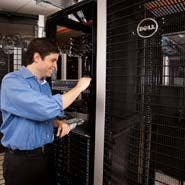Dell Revamps EqualLogic Storage Lines, Adds VMware Storage Integration
Dell on Monday revamped its Dell EqualLogic storage line with new hardware and software platforms including the ability to do load balancing between hard disk and SSD appliances based on the dynamic latency requirements of applications.
The company has also gone deep in terms of integrating VMware's virtualization technology with its EqualLogic, Compellent, and PowerVault storage platforms.
There is a lot of important news coming out of Dell storage, said Steve Bishop, CTO at VeriStor Systems, an Atlanta-based solution provider and long-time Dell and EqualLogic partner.

"This is a huge release for Dell," Bishop said. "It touches on a lot of different products. In fact, when I first looked at it, I though there's almost too many new things going on. People could easily overlook some things."
The new storage expansion, coming on the wake of multiple initiatives Dell unveiled in June at its Dell Storage Forum.
The changes are important as Dell looks to ramp up its storage business in the wake of its breakup with its previous primary storage product vendor, EMC. That relationship is quickly fading to insignificance as Dell ramps up sales of products based on its own intellectual property.
Dell on Tuesday reported that its overall quarterly storage revenue fell 20 percent from last year thanks to a 62-percent drop in EMC storage sales, but that sales of the company's Dell-branded storage rose 15 percent over the same period.
Dell now is counting on its own storage technology to make the company a top storage vendor, said Travis Vigil, executive director for Dell storage.
"Our storage business is at $2 billion today," Vigil said. "We want it to be $4 billion to $5 billion by calendar year 2015."
Dell appears to be on track to reach that goal, Vigil said. The company has about eight times the number of EqualLogic customers now than when it acquired EqualLogic in 2007, and that part of the business has grown an average of 61 percent since then, he said. And first-half 2011 revenue for its new Compellent storage product line, which it acquired early this year, is already higher than Compellent's entire 2010 revenue, he said.
Dell on Monday introduced two new hardware platforms for its EqualLogic line, Vigil said.
The new EqualLogic PS4100, which is replacing the company's PS4000 line, is a 2U iSCSI storage appliance featuring 6-Gbit SAS hard drives. It can be configured with 24 2.5-inch, 10,000-rpm or 15,000-rpm drives of 12 3.5-inch, 7,200-rpm drives. The older PS4000 fit a maximum of 16 3.5-inch hard drives in a 3U enclosure, Vigil said.
Also new is the PS6100, which is replacing the PS6000 line. The PS6100 family is available in a 2U enclosure with up to 24 2.5-inch hard drive or SSDs, and a 4U enclosure with room for up to 24 3.5-inch hard drives. The PS6000 featured a 3U chassis with room for up to 16 hard drives.
By moving from a maximum of 16 drives per chassis to 24 drives, drive count is increased by 50 percent while IO-per-second performance is increased by 67 percent, Vigil said. "So we're getting better density and performance all around," he said.
Also available is a hybrid version of the PS6100 which can be configured with seven 400-GB Pliant SSDs and 17 600-GB, 10,000-rpm hard drives, Vigil said.
Next: New Software Upgrades And VMware Integration
The PS4000 and PS6000 lines will go end-of-life this year, but will be supported for at least the next five years, a Dell spokesperson said.
The new PS4100 and PS6100 appliances take advantage of a recent upgrade to the EqualLogic firmware which allows automatic load balancing between multiple appliances, Vigil said.
That software up date looks at the relative latency between the nodes and in relation to the application, and moves data between SATA hard drive, SAS hard drive, and SSD nodes based on that latency. "As the storage starts to see higher latency on one node, it can find the specific bits of data and move them to a node with less latency," he said.
That is a huge plus for Dell EqualLogic, VeriStor's Bishop said.
"This puts the focus on application performance," Bishop said. "A lot of load balancing technology just looks at a block of data that has just been accessed. But application performance, not performance of a recently accessed block of data, is more important. Dell's focus on latency doesn't solve all application issues, but it is important because Dell balances latency across all storage resources."
Dell also unveiled multiple integration of VMware technology into its Dell storage hardware, including certification for use with VMware's upcoming vSphere 5.0 virtualization platform and support for VMware Site Recovery Manager 5.0.
In addition, the EqualLogic appliances also now support vStorage APIs for Array Integration (VAAI), which moves the processing needed for backing up of virtual machines away from the host server and to the storage array, as well as vStorage APIs for Storage Awareness (VASA), which helps select the appropriate disk for virtual machine placement. They also support VMware Dynamic Resource Scheduling.
The Dell Compellent appliances also include a VMware vCenter 5.0 plug-in, Vigil said.
The new VMware support is critical, Bishop said. "EqualLogic has always been on the forefront with VMware integration," he said.
Vigil said Dell has also started shipping its EqualLogic FS7500, a new appliance it first unveiled in June which the company's Exanet technology to add scaleable NAS capabilities to Dell's EqualLogic line of SAN appliances.
The FS7500 has no integrated storage capacity. Instead, it turns part of the capacity on customers' EqualLogic iSCSI SAN arrays into storage which can be use as a NAS. It is sold either as one or two two-node clusters, and allows a single FS7500 file share to scale to up to 510 TBs of raw capacity.